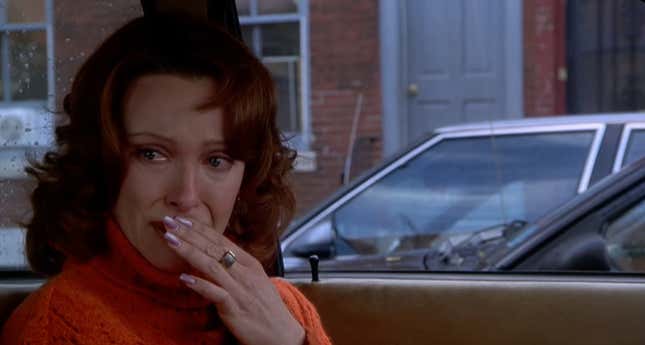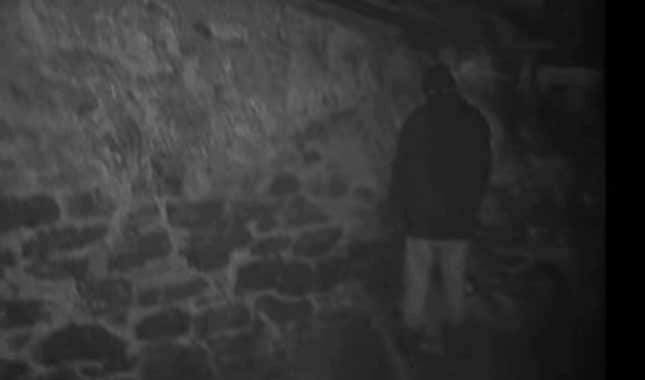Audiences at the time might have been fooled, but 25 year later, everyone knows The Blair Witch Project is a work of fiction. But even without that “true story” gimmick going for it, the movie remains surprisingly potent, both taken on its own and when considered in the context of not just 1999’s other horror releases, but the found-footage onslaught that followed in its wake.
Made on a shoestring budget (it eventually became one of the most successful indie films of all time) by writer-directors Daniel Myrick and Eduardo Sánchez, The Blair Witch Project arrived during a transitional time for the horror genre. The runaway success of Scream—another low-budget, high-yield release, as horror films often are—brought slashers back into fashion in 1996. While the trend was still percolating (1998 brought I Still Know What You Did Last Summer and Halloween H20: 20 Years Later), teen audiences that slashers targeted had begun to shift their attentions toward rom-coms, and 1999 delivered a bounty of those (just a few: She’s All That, 10 Things I Hate About You, and Never Been Kissed).
With masked killers taking a bit of a breather, 1999’s horror landscape had a range of offerings, including nostalgic epics like Tim Burton’s Sleepy Hollow and Brendan Fraser’s The Mummy; edgier fare like Antonia Bird’s Ravenous and David Cronenberg’s Existenz; creature features (Deep Blue Sea, Lake Placid, Bats); movies that eyed “the future” as Y2K loomed (The Thirteenth Floor, End of Days, Stigmata, The Omega Code—and though not horror, this was also the year of The Matrix); and two high-profile examples of classic horror remakes crashing into 1999’s version of high-tech special effects (The Haunting, House on Haunted Hill). The year also brought a pair of standout ghost stories. There was David Koepp’s Stir of Echoes, a Kevin Bacon-starring mystery chiller based on a Richard Matheson tale—and, of course, 1999’s only movie to come close to eclipsing The Blair Witch Project in terms of buzz and shock value: M. Night Shyamalan’s The Sixth Sense, which unlike Blair Witch notched six Oscar nominations, including a rare horror nod for Best Picture.

With a marquee star in Bruce Willis and a more traditional style (no handheld shaky-cam or grimy snot-rocket close-ups), The Sixth Sense matched its critical success with a huge commercial haul, with only Star Wars: Episode I – The Phantom Menace beating it on the year’s list of top earners. Everyone wanted to see the movie with the big twist and perfect their imitation of Haley Joel Osment’s “I see dead people” whisper. And in 2023, even with that twist long since spoiled and parodied and ripped off everywhere, The Sixth Sense still feels remarkably timeless thanks to its performances (Osment and Toni Collette in particular), Shyamalan’s elegant approach to genre filmmaking, and a story that’s really about grief and trauma… with genuinely scary moments sprinkled throughout.
But if The Sixth Sense claimed all the mainstream horror laurels, The Blair Witch Project was weaving its own magic in the independent space—and sparking the imaginations of filmmakers who realized not having access to certain resources (fancy cameras, budgets for sets and costumes, A-list actors, etc.) could actually work to their advantage. Blair Witch didn’t invent found footage, as any Cannibal Holocaust or Last Broadcast defender will tell you, but it opened up the realm of possibilities for the creators of Paranormal Activity, REC, Cloverfield, and the V/H/S series, not to mention the dozens of smaller films that didn’t spawn franchises but certainly made audiences shriek with delight.
As genre junkies well know, not every found footage horror movie is worth watching, and the instant popularity of the genre resulted in many unmemorable titles. You can’t just shove a camera at actors and tell them to run around and scream; while that may be an oft-repeated motif—inventing reasons for characters to stubbornly continue filming themselves is another—there has to be a compelling story capable of luring viewers in and holding their attention. The Blair Witch Project’s “this actually happened” feint is no more real than the “true story” claims at the start of The Texas Chain Saw Massacre, but there’s a grittiness and a sense of spontaneity that makes it feel like it could be authentic.
With the help of the real MVP of any found-footage film—the editor, the unseen hand that shapes the story lurking in presumably hours of “recovered” tapes—The Blair Witch Project introduces us to its three-person cast, who play characters named for the actors (Heather Donahue, Mike Williams, and Josh Leonard), and its premise: young documentarians exploring a spooky local legend. Thanks to an exposition dump early on, we learn that there’s a reason the community has kept the Blair Witch story going; the area’s had an unusual string of tragedies, including a serial child murderer in the 1940s, and people from all generations have their own stories about strange sightings in the nearby woods.
But Myrick and Sánchez, who directed their actors with the help of walkie-talkies, also begin building tension between the characters from the very start. Heather, Mike, and Josh start off excited and confident, but as they become more tired, cold, hungry, irritable, and frightened after becoming hopelessly lost, it becomes almost too frustrating to watch them scream at each other. Just when you’re starting to wonder if the real horror of The Blair Witch Project is how annoying everyone is, the film reminds you that this isn’t just people fumbling around in the wilderness—it’s a haunted wilderness. Folklore is made fact by the ominous sounds the trio hears when they’re trying to sleep at night, and the strange talismans (piles of rocks, those instantly iconic stick effigies) they find around their campsites. Is there some kind of evil in the land that’s keeping them from finding the path back to their car? That’s the implication as The Blair Witch Project becomes a disorienting, emotionally fraught trek through a landscape that feels increasingly hostile. A physical villain never appears; we never see the Blair Witch in any form. But the feeling that a malevolent force is out there clings to the edge of every frame.

And, of course, there’s that ending—the ultimate proof that you need to pay attention to everything said offhandedly in the film’s first 15 minutes, lest you miss one of the most powerful “oh shit” realizations horror has ever pulled off. The fact that Blair Witch just ends in that basement with that image—rather than rewinding to show you what you’ve missed, like The Sixth Sense does after its own “gotcha” finale—makes it all the more searing. We know now none of it was ever real. But in that moment, even watching it 25 years later, it still feels like it could be.
The Blair Witch Project streams free with ads on Amazon Freevee, Plex, and the Roku Channel.
Want more io9 news? Check out when to expect the latest Marvel, Star Wars, and Star Trek releases, what’s next for the DC Universe on film and TV, and everything you need to know about the future of Doctor Who.

